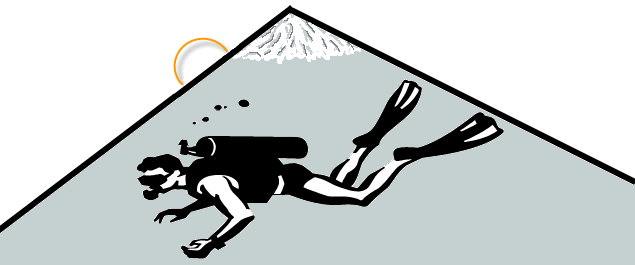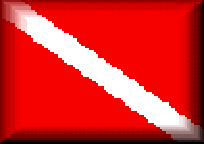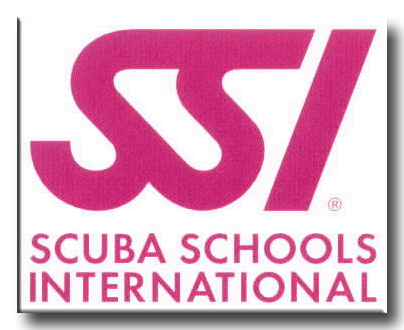|
Immaculate beaches and verdant hills, wildlife-rich rainforests and tumbling waterfalls,
imposing mountain ranges and vibrant cities, all wrapped in defiantly Revolutionary politics; the island of Cuba can
rightfully claim to be one of the most singular destinations on the planet.
The largest and most populous island in the Caribbean, Cuba's 1959 socialist revolution and the subsequent US trade
embargo has frozen the island in time; vintage American cars still roar through the ramshackle streets of its cities,
while horses and carts clatter through the countryside.
Cuba has a whopping 5,700km of coastline, and virtually all of it is a gateway to dive sites – with sunken wrecks,
vertical walls, colourful reefs and tiny cays providing endless opportunities for exploration – both directly from the
shore, and from dive boats. The water temperature averages around 24°C throughout the year, tending to be warmer on the
south coast, with visibility of 30-40m – these are dreamy dives indeed.
Many dive sites in Cuba are located close to its towns and cities or off stunning beaches, which means that scuba diving
trips can be easily built into a regular tour of the island; pretty much everywhere you stop along the coast will have
access to a dive site. This is also convenient for those who are travelling with non-diving partners or friends, as while
the diver bubbles about the reefs, their travelling companions can soak up the sun or the local culture – or perhaps
enjoy a snorkel. It also means you can enjoy dedicated dive holidays here along the length of the island, exploring a
different ocean ecosystem pretty much every day. For a more immersive diving holiday, head out to one of the offshore cays,
or splash out on a liveaboard yacht to reach Cuba’s most sought after dive sites such as Jardines de la Reina – the Gardens
of the Queen.
Cuba is almost entirely ringed with coral reefs, with some 50 species of coral thriving in the warmer Caribbean coast to the
south, and the slightly fresher Atlantic to the north. The island’s lack of industrialisation has meant that the reefs, and
the creatures that inhabit them, have remained largely undisturbed – a phenomenal treat for scuba divers, and a rare success
story at a time when pollution, trawling and rising sea temperatures are threatening coral across the globe.
Passport and/or Visa Requirements
Passport Validity - Your passport should be valid for the proposed duration of your stay. No additional period of validity
beyond this is required.
Make sure you get the right visa for your visit. As well as tourist visas, there are other visa categories for different
types of travellers. If you’re entering Cuba as a tourist, you’ll need to get a tourist card before you travel.
For more information and advice about visas, contact the Cuban Embassy.
If you’re a dual national, you should contact the Cuban Embassy
for advice on entry requirements before you travel.
Clothing
You don’t need to get dressed up in your best clothes each time you set foot outside, and it’s certainly not as though the locals
will. Dress for comfort, and not for style. Light, airy clothing is best for day to day wear, and you might find that you wear
little more than a pair of shorts and a T-Shirt during the day. A light sweater is also a good idea for when the sun goes down,
but only in the winter months. A wind breaker or rain slicker should be considered.
While it’s not a particularly formal society, it’s really not smart to think you can get away with dressing casually all the time
when it comes to what to wear in Cuba. If you show up to an upmarket bar or restaurant looking like you’ve spent the entire day on
the beach (which might actually be the case) then the chances are that they will politely decline to let you in.
You don’t need to bring a suit or a formal dress, but something “nice” to wear is highly recommended. A pair of light pants and a
cotton shirt will be more than enough, or a light dress. Since Cuba can be such a warm country, the keyword is light.
Water Quality & Health Risks
Tap water is not safe to drink. Bottled water is ubiquitous, but boiling water is recommended to limit plastic waste. Milk is pasteurised
and dairy products (with the exception of some cheap ice creams) are safe for consumption. Local meat, poultry, seafoods and fruit are
generally considered safe to eat.
Language
The official language spoken in Cuba is Spanish and it is the first language of about 90 percent of the entire population. Other languages
spoken in the country include Haitian Creole, Lucimi, Galician, and Corsican. The majority of Cubans only know Spanish, but in larger cities
and tourist areas, English is more commonly spoken.
Currency
In Cuba, cash is king. Your American credit and debit cards simply won't work. On top of that, Cuba has two currencies with very different uses.
The Cuban Convertible Peso (CUC) is the currency used in the tourism industry and the currency travelers will need the most. Exchange most or
all of your cash into CUC. The exchange rate for CUC is pinned to the US Dollar, which means 1CUC equals 1USD. Most restaurants, bars, museums,
taxis, stores (including local department stores), souvenir markets, lodging, and tourist transportations only take CUC. Most
travelers only exchange money into CUC. Everyone accepts CUC, you just may get change back in CUP.
The Cuban Peso Nacional (CUP) is the national Cuban currency, used primarily by locals in Cuba. The exchange rate fluctuates, but is typically
around 25CUP per $1USD. It is helpful to exchange a little bit of your money into CUP. As a traveler, you might use this type of Cuban currency
for street food, flea markets, colectivos, local neighborhood restaurants, ice cream stands, or giving tips.
Electricity
The electrical current in Cuba is the same as in the U.S. - 110 volts AC 60 Hz.
Time Zone
Cuba is in the Eastern time zone, just like New York and Miami in the USA.
Location and Size
Cuba is the largest country by land area in the Caribbean. Its main island is the seventeenth-largest island in the world by land area. The island
rises between the Atlantic Ocean and the Caribbean. It is bordered on the north by the Straits of Florida, on the northeast by Nicholas Channel and
the Old Bahama Channel. The southern part is bounded by the Windward Passage and the Cayman Trench, while the southwest lies in the Caribbean Sea.
To the west, it reaches to the Yucatán Channel, and the northwest is open to the Gulf of Mexico.
More than 4,000 islands and cays are found in the surrounding sea and bays. The southern coast includes such archipelagos as Jardines de la Reina
and the Canarreos. The northeastern shore is lined by the Sabana-Camagüey Archipelago, which includes Jardines del Rey and is composed of approximately
2,517 cays and islands.[3] The Colorados Archipelago is developed on the north-western coast.
Weather
Swept by northeasterly trade winds, Cuba enjoys a tropical climate, with year-round temperate weather. Cuba’s tourist high season is typically during
its drier season from December through mid-April. Temperatures average 69.8°F in January.
The official hurricane season in Cuba runs from June through November, with more rain occurring during these months due to tropical storm activity.
However, according to the NOAA (National Oceanic & Atmospheric Association), Cuba experiences the lowest frequency of hurricanes and tropical storms
than other parts of the Caribbean.
|
Diving Highlights
The warmth of the Cuban people is matched by the warm ocean that surrounds the archipelago country in which the reefs are little explored and undisturbed
which gives a unique experience as sea life, in particular, grouper and sharks, are curious and will interact closely with divers. Cuba is home to the
second largest reef in the world behind the Australian Great Barrier and, what's more, is that Cuban diving features long drop-offs or the Grand Canyon
which promises that dives are eventful and unforgettable.
This average visibility in the jade water is 98-131 feet (30-40m) which makes it possible to spot sharks and dolphins easily. There is no better site to do
just this than Jardines de la Reina (The Queen’s Garden) off the southern coast of the island and where sightings of Jewfish, Hawksbill turtles and an array
of sharks are common. The protected area allows no more than 300 divers a year and there are no inhabitants on the nearby island, therefore, the fish have
never learnt to fear humans. Their natural curiosity creates unbelievably close encounters.
The ease of diving these sites and others off the remote islands of Cuba is enhanced by the liveaboard option. These sea hotels travel from site to site
quickly and efficiently and decrease travelling time from the main island, which in turn increases time under the water.
Gardens of the Queen Dive Sites
⦿ Cabezo de la Cubera
The depth ranges from 18 to 63 ft. “Cabezo” is a Cuban marine term for an isolated coral formation on a sandy bottom. This place has a “cabezo” with a circular
shape, around 600 ft in diameter which is extremely impressive with big schools of dog snapper and cuberas in the water column above the coral; mutton,
yellowtail snapper schools between the coral patches, Caribbean reef sharks, different species of groupers, sting rays, turtles. After going around the coral
formation divers get to a shallow wall with clouds of purple blue tangs and massive schools of tarpon crossing by.
⦿ Black Coral I
Depth ranges between 72 and 96 ft. Coral bands that grow higher near the edge of the platform (drop-off) are more than 30 ft high over the sand patches in the
bottom between them, abundant colonies of black coral, a resident population of more than 20 Caribbean reef sharks, huge black groupers come close to the divers
all the time, schools of jacks rubbing their bodies against the sharks to clean parasites away, parrot fish schools, clouds of school masters and yellowtail
snappers, also rainbow runners and oceanic triggerfish.
⦿ Black Coral II
Depth ranges between 60 and 90 ft. Impressive coral mountains near the edge of the platform, resident population of more than 25 reef sharks (Carcharinus Perezi)
patrolling the coral mountains. Big colonies of black corals, large sponges, depth gorgonians, midnight parrotfish schools, king mackerel, black groupers, moray
eels, hawksbill, and a friendly nurse shark comes very close to the divers. In the blue passing schools of oceanic triggerfish and lonely eagle rays.
⦿ Five Seas
Depth ranges between 21 and 66 ft. Under the wall there are overhangs with impressive resident schools of tarpon, black corals, and colorful sponges, divers go
under and tarpons get as close as two inches from the mask to turn away with a shining silver flash. Resident population of more than 15 Caribbean reef sharks,
snappers, black groupers, Goliath grouper (Epinephelus Itajara) comes very close. There is a wreck 15 meters long, it was a boat of Júcaro harbor that was used
as a pilot boat and its name was Five Seas, was sunk intentionally, the remaining parts of the boat are full of corals, sponges, schools of jacks and black corals,
also green moray eels.
⦿ Octopus Cave
Depth ranges between 15 and 54 ft. There is a wall full of sponges and gorgonians, tarpon schools, Caribbean reef sharks and Goliath groupers over 200 pounds,
impressive schools of grunts, porgies and mullet around big pillar corals in the edge of the wall, also big clouds of school masters. Pillar corals are over 6 feet
high and are cleaning stations for large and small reef fish. There is a cave at 18 feet with a horizontal development of its gallery of over 230 ft., but it is
restricted and you can only explore the entrance, the cave is inhabited by “brotulas”, a blind fish, they can only be seen at night. There are also iridescent sponges
with decorator crabs.
⦿ Cabezo de la Raya
Depth between 15 and 63 ft. Circular coral formation more than 900 ft. in diameter, forming bands of coral in the sand, many sting rays in the sandy areas, nurse
sharks, Caribbean reef sharks, Goliath grouper, black and Nassau groupers, hawksbills, king mackerel. At the end the dive finishes at 15 ft. in a shallow wall full
of reef fish, grunts, schoolmasters, parrots, barracudas, angelfish, blue tangs, mullet, nudibranchs, etc.
⦿ Los Mogotes
Amazing visibility, “Mogotes” is the name Cuban fishermen give to coral formations in a white sandy bottom, as they see these from the boat as darker areas in the sand.
Depth ranges between 21 and 63 ft. There is a wall with some overhangs full of black coral, small caves with tarpon schools especially in May, June, July, constantly
patrolled by Caribbean reef sharks, big black groupers, jacks, crabs, and many reef fish in the shallow zone.
⦿ Pipin
Drop-off wall dive, between 45 and 105 ft. deep, with many coral canyons, resident school of Silky sharks (Carcharhinus falciformis) swimming near the boat all the
time and Caribbean reef sharks in the deep. Black corals, huge spotted eagle rays, tarpon, jacks, snappers, turtles. Big colonies of black corals.
⦿ El Farallon
Coral formation between 45 and 160 ft. crossed by some ruptures where the corals are 30ft. high over the sand and 6 ft. wide, some of this impressive tunnels barely
open in the top allowing the rays of light to enter forming an spectacular view, divers go across two tunnels and then go to the drop-off full of black corals and hanging
sponges, black groupers, goliath grouper, snapper, caribbean reef sharks and silky sharks.
⦿ Russian Mountain
Drop-off, perpendicular wall, the dive goes between 66 and 105 ft. with large coral canyons, big schools of jacks, black corals, huge sponges, Silky and Caribbean reef
sharks, occasionally a giant lonely great hammerhead (Sphirna mokarran) emerges from the depth to take a quick view of the divers. Turtles, snappers, and groupers.
⦿ Vicente
Large cylindrical coral formations at the edge of the wall as pinnacles that rise 72 ft. from a deep sandy bottom, the dive goes between 114 and 60 ft. from top to top
of these intricately decorated coral mountains, with all species of sponges, corals, gorgonians, very colorful drop-off, also large groupers, Caribbean and Silky sharks,
and occasionally a huge great hammerhead comes up curious. Spotted eagle rays flying parallel to the wall.
⦿ Avalon
Frontal edge of the reef wall, between 72 and 110 ft. full of big black coral colonies, and depth gorgonians, groupers, silky and Caribbean reef sharks, massive iridescent
sponges, is a very colorful wall, eagle rays are seen here very often, also goliath groupers, hammerheads occasionally. Some impressive canyons in the deeper areas of the wall.
|








